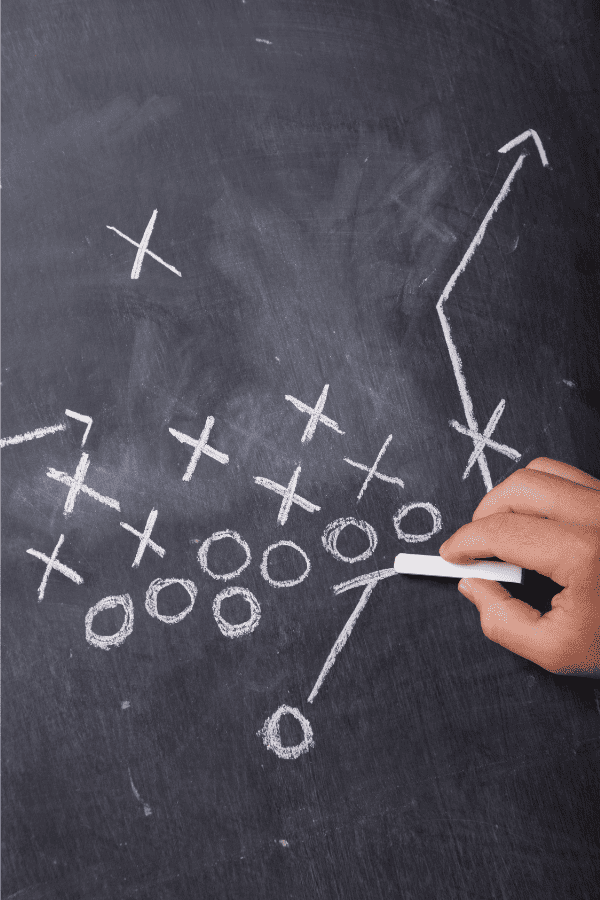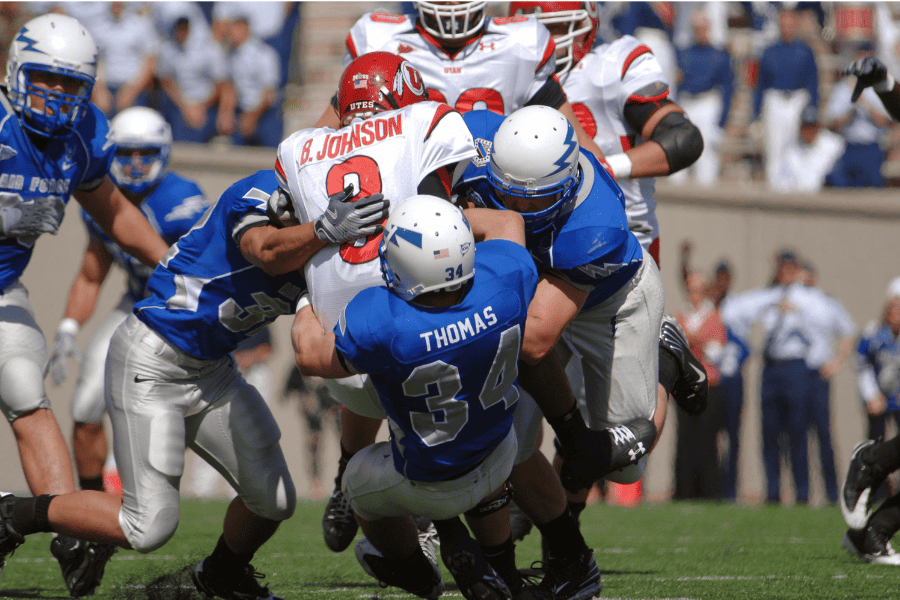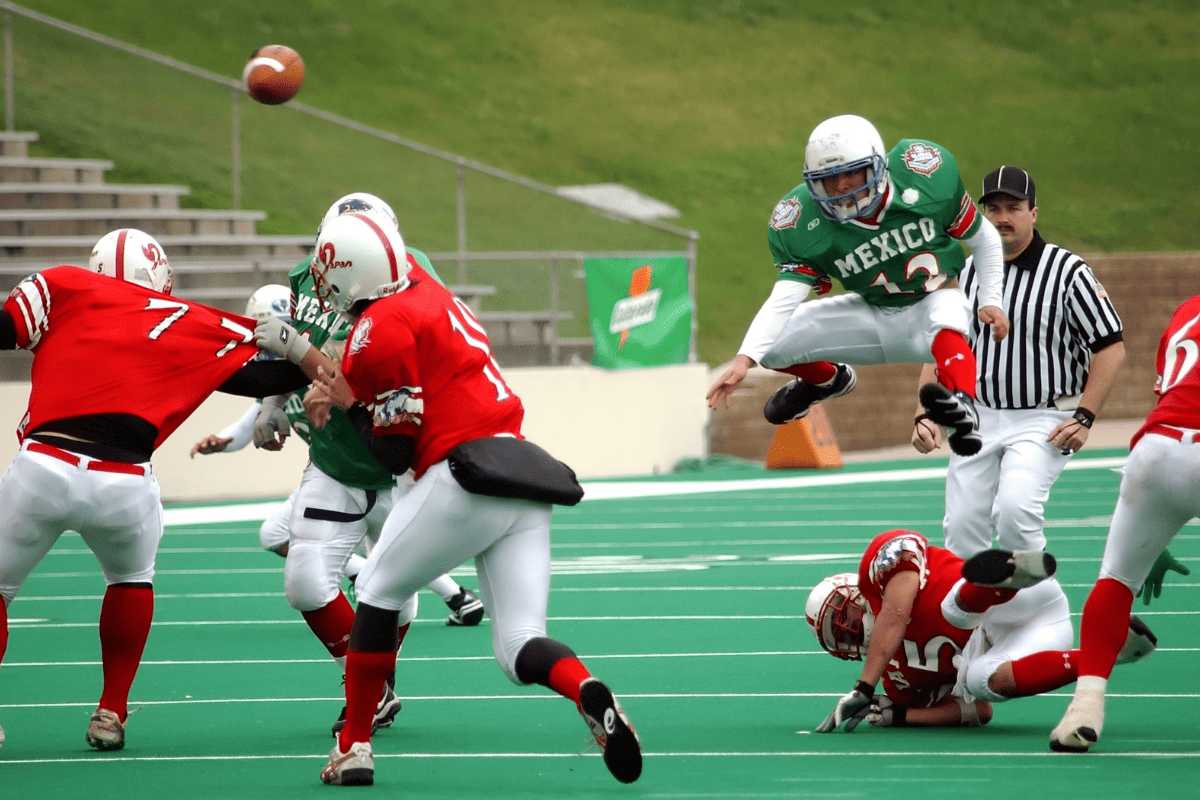What is “The Pocket” in Football? (All You Need to Know)
The pocket in football is a term used to describe the protective barrier or ‘pocket’ created by the offensive line to guard the quarterback.
When the football is snapped, the offensive line players, which include the center, guards, and tackles, spread out in a semi-circle or arc formation (more on this later). This formation is designed to keep defensive players from reaching the quarterback, thus giving the quarterback time to analyze the field, find a receiver, and make an accurate throw.
The term “pocket” refers to this protective area, similar to a pocket you might find in clothing, in which the quarterback is intended to remain until he executes a play.
Importance and Purpose of the Pocket
The pocket is of immense importance in a football game for a number of reasons.
Primarily, it is designed to provide the quarterback with the time and space he needs to make the best play possible. Without a well-formed pocket, the quarterback may be rushed into throwing the ball before he’s ready, leading to inaccurate passes or interceptions.
The pocket acts as a barrier between the quarterback and the defensive players. In the absence of a pocket, the quarterback would be much more exposed to tackles and sacks from the defensive line, potentially leading to lost yardage, turnovers, and even injuries.
Lastly, the pocket is not just a physical space but also a strategic one.
It serves as a significant part of an offensive team’s strategy, influencing decisions such as what type of pass to execute, whether to run with the ball, and/or when to throw the ball away.
Understanding the Formation of the Pocket

Roles of the Offensive Line
The creation of the pocket is mainly the responsibility of the offensive line, composed of the center, two guards, and two tackles. Each player has a specific role that contributes to the formation of a successful pocket.
The center, positioned in the middle of the line, is responsible for initiating the play by snapping the ball to the quarterback. Following the snap, the center typically has to block a defensive tackle or a blitzing linebacker.
The goal of the center is to maintain their block relatively close to the line of scrimmage and not be pushed backward which would result in the pocket being collapsed.
The guards, positioned on either side of the center, have the job of protecting the interior of the pocket. They must be adept at both pass protection and run blocking. Often, they are responsible for blocking defensive tackles or helping the center.
They can give up a little more ground than the center on their blocks, but not much.
The tackles are on the outer ends of the offensive line. The left tackle, who protects the quarterback’s blind side (assuming a right-handed quarterback), often faces the opponent’s best pass rusher. The right tackle’s primary role is to block and prevent the defensive ends or blitzing linebackers from rushing around the outside edge.
The tackles are able to give up ground vertically, but not horizontally. This means tackles can let their defender run upfield as long as they don’t allow them to collapse the outer edge of the pocket.
The combination of these roles creates a barrier that forms the pocket. Offensive linemen must maintain their blocks and balance to prevent defensive players from breaking through the pocket and reaching the quarterback.
Positioning and Responsibilities of Quarterbacks

The quarterback plays a critical role in maintaining the integrity of the pocket. After receiving the snap, the quarterback typically takes a set number of steps backward into the pocket, known as the “drop back”. This step back allows the offensive line to engage the defensive players and solidify the pocket.
Quarterbacks must have excellent spatial awareness to feel the shape and security of the pocket. They must be able to sense when the pocket is collapsing or when a defensive player has broken through the line, indicating that they need to throw the ball or escape the pocket.
Additionally, quarterbacks must maintain discipline in staying within the pocket as long as possible, only escaping when necessary.
Leaving the pocket prematurely can disrupt the blocking assignments of the offensive line and expose the quarterback to defensive players. Quarterbacks also have the responsibility of throwing the ball away if no passing options are available, in order to avoid a sack and prevent loss of yardage.
Types of Pockets in Football
Traditional Pocket
The traditional pocket is the most commonly utilized form in professional football and the one we’ve been describing up to this point. The offensive linemen spread out in a roughly half-moon shape after the snap, with the tackles typically dropping back slightly to keep defensive ends from easily reaching the quarterback.
The quarterback will take a few steps back (a three-step, five-step, or seven-step drop depending on the play call) to allow the pocket to form. The traditional pocket prioritizes protection over mobility, providing the quarterback with ample time to analyze the field, identify an open receiver, and deliver an accurate pass.
Moving Pocket
Also known as a rollout, the moving pocket is a variant where the quarterback, along with the offensive line, moves to one side of the field after the snap. The purpose of this is to create space and time for the quarterback, giving him the option to either pass the ball or run with it.
This is often utilized with quarterbacks who have the athleticism to scramble and gain yardage on foot. The moving pocket can be an effective strategy to counteract a strong defensive line or pass rush, as it physically moves the quarterback away from the pressure.
Quick Pocket
A quick pocket isn’t really a pocket at all and is typically used in situations where a quick pass is required, such as quick screen passes or slant routes.
In these cases, the offensive line will not drop back as much or they may jump forward and attempt to cut block the opposing defensive linemen (so they are not able to jump up and knock down the pass). The quarterback will take fewer (if any) steps back, sometimes throwing the ball immediately after receiving the snap.
This type of pocket is designed to get the ball out of the quarterback’s hands quickly before the defensive line has a chance to collapse the pocket.
Defending Against the Pocket

Thus far we’ve discussed what the pocket is, how the offense creates a pocket and how it uses it to its advantage.
But, what about the defense?
Let’s discuss how the defense can defend and disrupt the pocket to stop the offense.
Strategies Used by Defensive Line
Defending against the pocket is a primary responsibility of the defensive line, composed of the defensive ends and defensive tackles. Their primary goal is to disrupt the pocket, either by collapsing it to sack the quarterback or pressuring him into making a hasty, potentially inaccurate throw.
One common strategy is the bull rush, where defensive linemen attempt to overpower their offensive counterparts through sheer strength and momentum, pushing them back into the quarterback. Other techniques include the swim move or rip move, where defensive linemen use agility and hand techniques to slip past offensive linemen.
Additionally, defensive linemen can also attempt to block the quarterback’s passing lanes, jumping to deflect passes or obstruct the quarterback’s view of the field.
Bluff and Blitz Techniques
Bluff and blitz techniques involve deceptive tactics to confuse the offense and disrupt the pocket. A bluff occurs when a defensive player pretends to rush the quarterback but instead drops into pass coverage.
This can confuse the offensive line’s blocking assignments and potentially leave a path open for another defensive player to rush the quarterback.
A blitz, on the other hand, is when additional players beyond the defensive line rush the quarterback. This can include linebackers or even defensive backs. The aim of a blitz is to overwhelm the offensive line with sheer numbers, creating a gap in the pocket for a sack.
Role of Linebackers and Defensive Backs
Linebackers and defensive backs play a crucial role in defending against the pocket. While they may occasionally blitz, their primary role is in pass coverage, aiming to intercept or deflect any passes thrown by the quarterback.
Linebackers typically cover the middle of the field, watching for short to medium range passes. They also play a critical role in containing a quarterback who escapes a collapsing pocket, preventing him from gaining substantial yardage on foot.
Defensive backs, including cornerbacks and safeties, cover receivers and the deeper parts of the field. They aim to prevent any long-range passes from being completed. In some situations, they may also be called upon to blitz, adding another layer of pressure on the pocket.
In essence, defending against the pocket involves a combination of pressure from the defensive line, deceptive blitz and bluff tactics, and effective pass coverage from linebackers and defensive backs.
Final Thoughts
The pocket in football plays a pivotal role in the offensive strategy, serving as the foundational basis for most successful passing plays.
It represents the protective space for the quarterback, created by the combined efforts of the offensive line. Its primary function is to offer the quarterback time and space to analyze the field, choose the most appropriate receiver, and execute an accurate throw.
On the other hand, the defensive team’s main goal is to disrupt this pocket. Techniques employed by the defensive line, coupled with blitz and bluff strategies, and the roles played by linebackers and defensive backs, all contribute to challenging the integrity of the pocket.
Football, like many other sports, is a constant learning journey, with the pocket being just one element of the game. We encourage you to continue exploring, learning, and understanding the different elements that make football the exciting and strategic game that it is!

